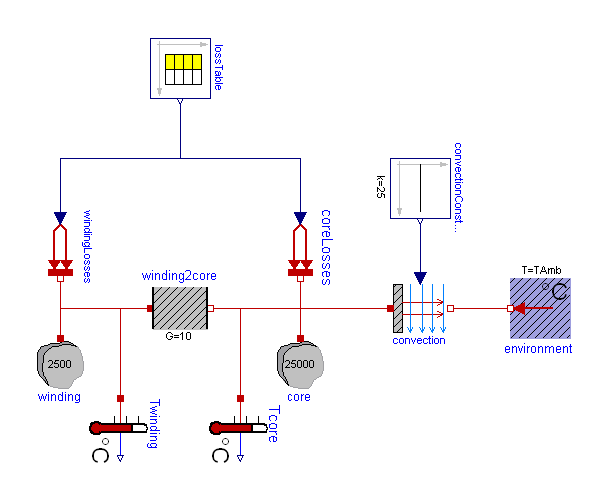 Modelica.Thermal.HeatTransfer.UsersGuide
Modelica.Thermal.HeatTransfer.UsersGuide Modelica.Thermal.HeatTransfer.UsersGuide
Modelica.Thermal.HeatTransfer.UsersGuide
This package contains components to model 1-dimensional heat transfer with lumped elements. This allows especially to model heat transfer in machines provided the parameters of the lumped elements, such as the heat capacity of a part, can be determined by measurements (due to the complex geometries and many materials used in machines, calculating the lumped element parameters from some basic analytic formulas is usually not possible).
Example models how to use this library are given in subpackage Examples.
For a first simple example, see Examples.TwoMasses where two masses
with different initial temperatures are getting in contact to each
other and arriving after some time at a common temperature.
Examples.ControlledTemperature shows how to hold a temperature
within desired limits by switching on and off an electric resistor.
A more realistic example is provided in Examples.Motor where the
heating of an electrical motor is modelled, see the following screen shot
of this example:

The filled and non-filled red squares at the left and right side of a component represent thermal ports (connector HeatPort). Drawing a line between such squares means that they are thermally connected. The variables of a HeatPort connector are the temperature T at the port and the heat flow rate Q_flow flowing into the component (if Q_flow is positive, the heat flows into the element, otherwise it flows out of the element):
Modelica.Units.SI.Temperature T "Absolute temperature at port in Kelvin"; Modelica.Units.SI.HeatFlowRate Q_flow "Flow rate at the port in Watt";
Note, that all temperatures of this package, including initial conditions, are given in Kelvin. For convenience, in subpackages HeatTransfer.Celsius, HeatTransfer.Fahrenheit and HeatTransfer.Rankine components are provided such that source and sensor information is available in degree Celsius, degree Fahrenheit, or degree Rankine, respectively. Additionally, in package Modelica.Units.Conversions conversion functions between the units Kelvin and Celsius, Fahrenheit, Rankine are provided. These functions may be used in the following way:
import Modelica.Units.SI; import Modelica.Units.Conversions.from_degC; ... parameter SI.Temperature T = from_degC(25); // convert 25 degree Celsius to Kelvin
There are several other components available, such as AxialConduction (discretized PDE in axial direction), which have been temporarily removed from this library. The reason is that these components reference material properties, such as thermal conductivity, and currently the Modelica design group is discussing a general scheme to describe material properties.
For technical details in the design of this library, see [Tiller2001].
Extends from Modelica.Icons.Information (Icon for general information packages).
| Name | Description |
|---|---|
| Contact | |
| Release Notes | |
| References |
 Modelica.Thermal.HeatTransfer.UsersGuide.Contact
Modelica.Thermal.HeatTransfer.UsersGuide.Contact
Anton Haumer
Technical Consulting & Electrical Engineering
D-93049 Regensburg, Germany
email: a.haumer@haumer.at
Copyright © 2001-2020, Modelica Association and contributors
Acknowledgements:
Several helpful remarks from the following persons are acknowledged:
Extends from Modelica.Icons.Contact (Icon for contact information).
 Modelica.Thermal.HeatTransfer.UsersGuide.ReleaseNotes
Modelica.Thermal.HeatTransfer.UsersGuide.ReleaseNotesExtends from Modelica.Icons.ReleaseNotes (Icon for release notes in documentation).
 Modelica.Thermal.HeatTransfer.UsersGuide.References
Modelica.Thermal.HeatTransfer.UsersGuide.References| [Fischer2017] | R. Fischer, Elektrische Maschinen (in German), 17th edition, Hanser-Verlag, 2017 |
| [Holman2010] | J. P. Holman, Heat Transfer, 10th edition, McGraw-Hill, 2010 |
| [Tiller2001] | Michael Tiller, Introduction to Physical Modeling with Modelica, Kluwer Academic Publishers Boston, 2001 |
Extends from Modelica.Icons.References (Icon for external references).
Automatically generated Thu Oct 1 16:08:14 2020.